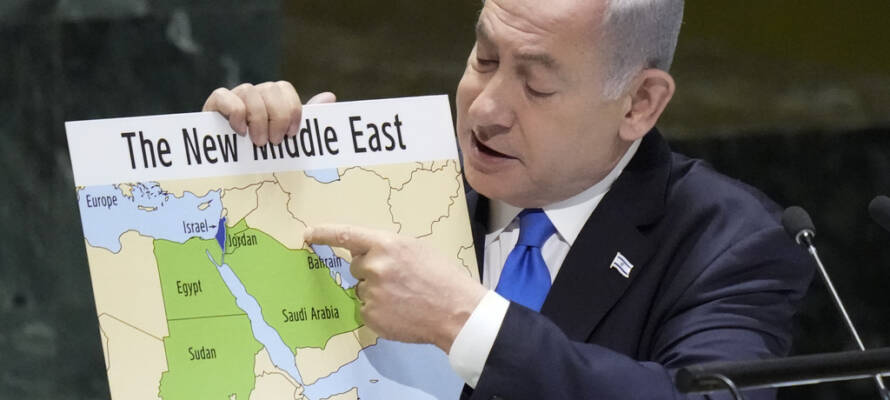Recent NYT articles about Iran and Israel aptly demonstrate Netanyahu’s criticism of narrative in which ‘good is portrayed as evil, evil as good.’
By Ira Stoll, The Algemeiner
In Prime Minister Netanyahu’s speech Friday at the U.N. General Assembly, he spoke of “moral confusion,” in the contest between Iran and Israel, in which “good is portrayed as evil, and evil is portrayed as good.”
Netanyahu didn’t call out by name the New York Times’s coverage of the conflict, but the description aptly applies, as two recent examples of Times coverage of Iran demonstrate.
A September 25 Times “news analysis” by Steven Erlanger is headlined “Iran’s Dilemma: How to Preserve Its Proxies and Avoid Full-Scale War.” The headline signals what is coming: a story that looks at the situation from Iran’s point of view.
“Iran has so far refused to be goaded by Israel into a larger regional war that its supreme leader, Ali Khamenei, clearly does not want, analysts say,” the Times article reports. That portrays Israel as trying to goad Iran into a regional war, instead of the reality, which is that Israel simply wants to exist in peace.
Who are these “analysts” the Times is relying on? The first one mentioned is the president of Iran, Masoud Pezeshkian. “In New York this week, Mr. Pezeshkian was blunt. Israel was seeking to trap his country into a wider war, he said.” The Times swallows that spin without the skepticism it warrants.
The Times reports, “Iran faces clear dilemmas. It wants to restore deterrence against Israel…It wants to preserve the proxies that provide what it calls forward defense against Israel — Hezbollah, Hamas and the Houthis in Yemen…” This idea that Iran is on “defense” against Israel rather than trying to wipe the Jewish state off the map is farfetched.
Then the Times article refers to “one reason that Iran had so far not retaliated for the assassination of the Hamas leader Ismail Haniyeh while he was in Iran.” Iran has indeed retaliated, or at least attempted to; fortunately, most, though not all, of the attacks have failed or been blocked by Israel.
Finally the Times acknowledges in passing that “Since the overthrow of the shah in 1979 and the installation of the Islamic Republic, Iran has tried to spread its influence throughout the region and has vowed to destroy Israel.” That’s useful context, but the Times leaves out that Iran has also vowed to destroy America, literally “death to America” is the slogan chanted and displayed at government-sponsored rallies.
The Times quotes an “Iran expert” and former Obama administration official at the Brookings Instiution, Suzanne Maloney, who claims, “Israel is trying to bait Hezbollah into an attack that would produce a full-fledged war.” Israel, which has already been attacked by thousands of Hezbollah rockets and drones and which would be happy to be left alone by Hezbollah, is given no opportunity to rebut this preposterous claim.
The Times explains further, “The proxies represent Iran’s strategy of forward defense, to protect the Iranian homeland.” This is laughable, and, in the case of Hamas, obscene, as if the October 7, 2023 rampage against Israel was a matter of “defense” aimed at protecting “the Iranian homeland.”
Even the commenters on the New York Times website thought this was a bit much. “The chutzpah of this article knows no bounds,” wrote one reader, a “BRJ” from New Jersey. “Iran is not the victim here. They are the world’s largest exporter of terror. If they are so concerned about Israeli attacks on Iranian soil, then perhaps they should stop vowing to destroy Israel and funding and supporting its proxy armies that surround Israel.”
The Times did no better in a news article by Farnaz Fassihi reporting Pezeshkian’s U.N. speech.
The Times reports: “Mr. Pezeshkian defended Iran’s support of the militant networks known as the ‘axis of resistance’ in the Middle East which have taken up arms against Israel, including Hamas in Gaza and Hezbollah in Lebanon. He called the networks ‘popular liberation movements of people that have been victims of four generations of the crimes and colonialism of the Israeli regime.’” That leaves out that these terrorist groups have also been attacking American ships and bases in the region, along with commercial shipping traffic.
The same Times article offers tilted context: “In April, after Israel struck Iran’s Embassy in Damascus, Syria, Iran retaliated by launching hundreds of drones and missiles against Israel. And Tehran vowed revenge after Israel assassinated Hamas’s political leader, Mr. Haniyeh, but after intense diplomatic efforts military commanders said Iran would retaliate at a time and place of its choosing.” The Times frames the Iranian attack as a retaliation rather than a continuation of a long-running effort to destroy Israel and America, and also frames Iran’s second supposed lack of retaliation as a choice rather than as an execution failure.
The Times describes Pezeshkian’s speech as “unusually reconciliatory in tone and words,” crediting him for not engaging in Holocaust denial. Yet the quotes in the article have Pezeshkian describing the Hamas and Hezbollah terrorists as “popular liberation movements,” and have Pezeshkian accusing Israel of engaging in “barbarism.” How that is “reconciliatory” is beyond me. It sure does validate that Netanyahu was onto something real when he identified the issue of “moral confusion.”
Ira Stoll was managing editor of The Forward and North American editor of The Jerusalem Post. His media critique, a regular Algemeiner feature, can be found here.
